 |
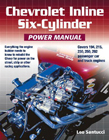 |
 |
Weiand 6 Pack Manifold Comments
by Jeffrey Diamond
The Original “6-Pack” |
Chrysler equipped high-performance 440 6-Pack (or 6-Bbl.) motors with three Holley Model 2300 2 bbl. carburetors from 1969-71. The original manifold (produced in both cast-iron and aluminum) is a dual-plane (180°) design, still available from Edelbrock as CH-6B.
The carburetors' flow capacity is rated in CFM (cubic feet of air per minute): 350 CFM (center carburetor: throttle disc 1.500”, venturi 1.1875”) or 500 CFM (end carburetors: throttle disc 1.6875”, venturi 1.375”), for a total of 1350 CFM. However, this rating is at 3” Hg vacuum (the industry standard for 2 bbls.). If rated by the same standard as 4 bbls. (1.5” Hg vacuum), the capacity totals 955 CFM, and this figure should be used for comparison to other high-performance intake systems. Since each cylinder is only supplied with mixture from one side of each carburetor (a total of three barrels, not six), the capacity available to each cylinder is 477 CFM. |
Other 3 X 2 bbl. Manifolds
|
Other manifolds using three 2 bbl. carburetors have been made for RB motor over the years, Weiand and Offenhauser are possible sources (an older Weiand for B engines is shown below, left as “Generic 3 X 2 Manifold”). However, these manifolds are quite different than the Chrysler/Edelbrock OEM type. They are all 360°, or divided single plane design. Click here for more description of intake manifold types:  . Note that the runners for an adjacent pair of cylinders (such as 1 & 3) are the same height; this is a good visual indicator of single-plane design. Compared to the Chrysler/Edelbrock manifold, they are lower, lighter, have less efficient mixture distribution and are less powerful. . Note that the runners for an adjacent pair of cylinders (such as 1 & 3) are the same height; this is a good visual indicator of single-plane design. Compared to the Chrysler/Edelbrock manifold, they are lower, lighter, have less efficient mixture distribution and are less powerful.
There was also another Edelbrock manifold (also previously available from Chrysler but now discontinued), the “street tunnel-ram”: part # STR-14-6 (shown below, right as “Edelbrock STR-14-6”). This was another attempt to improve peak power, using a common plenum and long runners. In this case, the runners crossed over as well (much like the Max Wedge and race hemi manifolds). The picture shows it to be somewhat lower than the Weiand 6-Pack, but wider. This manifold was also available with several different top plates for other carburetor choices; click here for more details of STR manifold types:  . . |
Generic 3 X 2 Manifold |
Edelbrock STR-14-6 |
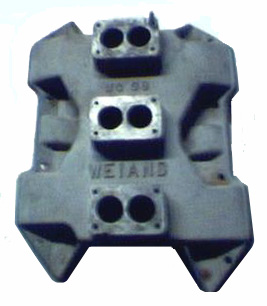 |
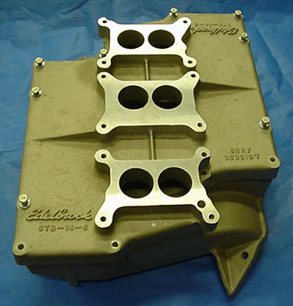 |
|
Weiand Manifold Description |
Weiand (now part of Holley; the name is pronounced “why-and”; this note is frequently found cast into older Weiand manifolds) once produced an intake manifold as a replacement for the Chrysler RB units. The purpose was Super Stock racing, which permits any manifold of the original type to be used, but only with the original carburetors. It was available through Chrysler as Part # P3690982 (now discontinued).
The Weiand is taller than the original, but still clears hoods in the vehicles originally equipped with the 6 pack manifolds. Hood clearance in an A body will probably be very limited. |
Manifold Exterior I |
Manifold Exterior II |
 |
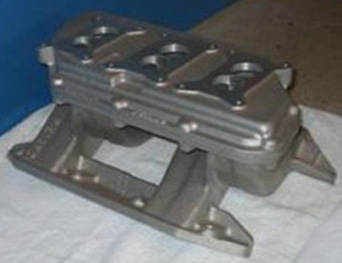 |
Weiand Manifold Function |
These pictures show that the Weiand is much different in size and design from the original factory manifold. The improvements were intended to benefit peak power only, by (in effect) making a “tunnel ram”.
A common plenum (shared by all cylinders, see “Interior of Plenum”, below, center) under the carburetors provides more mixture volume. This effectively more than doubles the carburetor capacity available to each cylinder, since each runner is supplied with mixture by all six barrels, as well as mixture “stored” in the plenum.
The runners in a conventional tunnel ram are nearly vertical, making the manifold extremely tall, but the runner length is still too short for the limited RPM range of a 440 motor (especially with a “legal” cam). The Weiand runners are lengthened by “crossing over”; the driver's side runners terminate in the plenum on the passenger's side and vice versa (see “Manifold Exterior I & II”, above). This extra length moves the torque peak down to a reasonable level suitable to a 3.75” stroke motor. |
Manifold Top Cover |
Interior of Plenum (Cover Removed) |
Plenum Spacer |
 |
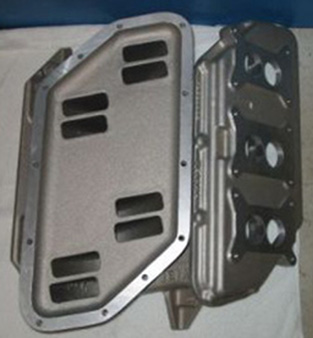 |
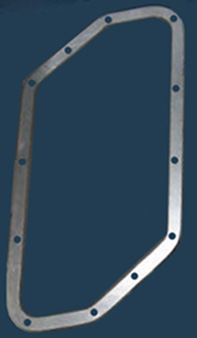 |
Weiand Manifold Modification |
The very low mixture velocity in the plenum will cause fuel to “drop out” of suspension, form large droplets, and collect on the plenum floor. This leads to poor idle quality, plug fouling and irregular mixture distribution between cylinders. Although this cannot be completely cured, the factory suggested some modifications (see “Chrysler Factory Jetting and Manifold Modification”, below) to improve mixture distribution.
For improved peak power (at the expense of mid-range), the plenum can easily be enlarged by fabricating a spacer to go between the cover and base (see “Plenum Spacer”, above, right), with the added volume proportionate to the spacer thickness. This is only likely to be of use if the motor has been stroked, or the RPM range raised considerably.
For improved “street manners” the plenum volume cannot easily be reduced, but the mixture inside the plenum can be made more active by adding raised and radiused entries to the runners where they join the plenum floor. The added height prevents puddled fuel from entering the runner. The shape of the added material should be a ½-donut (torus); I suggest ¾” diameter.
“Stuffing blocks” can be installed inside the plenum. These are usually made from hardwood, and secured to the plenum floor or cover with screws. They should be positioned in the areas between the runner entries. The volume of the wood lowers the plenum volume, increasing the signal to the carburetors and mixture speed.
Another improvement is to add “bore extensions” to the underside of the cover extending the carburetor bores down closer to the runners. These are simply tubes the same ID as the throttle disc (frequently made from exhaust tubing) extending straight down into the plenum. This will not change plenum volume, but will keep mixture speed slightly higher as it enters the plenum.
The following jetting information is taken directly from the Chrysler manual, and does not take into account any modifications other than those in the diagram. |
Chrysler Factory Jetting and Manifold Modification
|
Function | Throttle Side | Dia. Side |
Front carb main restriction: | .106” | .067” |
Center carb Jet | #78 | #78 |
PVCR: | .043” | .052” |
Rear carb main restriction: | .086” | .071” |
Idle restriction end plates: | .052” |
Pump shooter: | .025” drilled |
Accelerator pump cam: | Blue 41R-427 |
Diaphragm spring: | Brown or Purple |
Production kill bleeds in end carbs |
Power valve: | 2.5 |
| 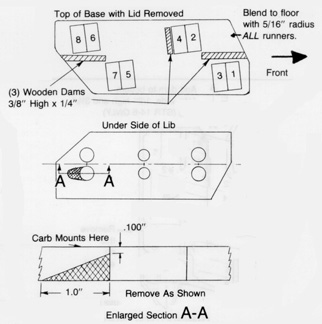 |
Weiand Manifold Modification |
Here are some modifications made by Dennis Grossman (“6bblFLASH”). Click on each to see the full-size version on a separate page. |
From Dennis: “After MANY attempts at making this manifold work as per Direct Connection Tech Bulletins, I decided to go my own way. I reduced the plenum volume as per photos,and added the tear drops on the floor to attempt to keep fuel from puddling on the floor. Added a raised edge around the runners also to stop puddled fuel from running down the runners. After the photos I added a higher edge around the runners for #5 & 7 to stop a highspeed miss and plug fouling on cyl. #5.
Started with jetting same as stk. EDELBROCK intake front carb: 77, center: 66, rear: 79. MECHANICAL CARBs. #0-4783
Ran well but missed at top of each gear, #5 plug fouls. Added raised edge on #5-7, fixed problem.
Raised jetting to (1) 80, (2) 68, (3) 82. This change resulted in a .09 reduction in E.T. in the 1/8th. and 1.3mph improvement.
I`m happy with the results so far,but expect to gain another 10th as I settle on the optimum runner size and jetting.
The actual improvement so far is 21/100ths, and
2.3 mph from the D.C. set-up and where it is today: 6.42 ET @ 106.63 mph,
1.42-60ft., 3,070 wt., 440/3.75stroke, 4.10 ratio, .590" D.C. cam, 12.34-1 CR,
93 octane - unleaded.
These mods are for development purposes ONLY,
and as I make progress I will make more refined mods in a more ‘professional
appearing method’.” |
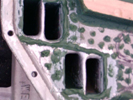 |
|



